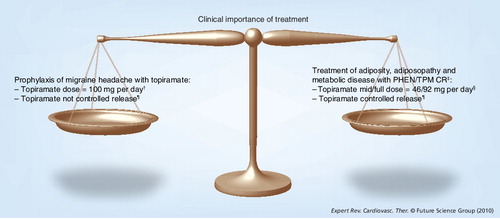Figures & data
CNS factors may increase anorexigenic POMC (which is cleaved to form melanocortins such as MSH) and CART expression, and decrease orexigenic expression of NPY and AgRP. Alterations in these appetitive effectors contribute to ‘second-order’ signaling through arcuate nucleus neuron projection to other hypothalamic regions. The net result is increased anorexigenic and increased catabolic effects, with decreased orexigenic and decreased anabolic effects. This figure is greatly simplified, and does not show all the interconnected signaling pathways between these CNS factors.
†The reported effects of these CNS factors on POMC and NPY are not always consistent in the literature, with more research needed to confirm these effects.
‡While CNS adiponectin may have anorexigenic effects Citation[175], adiponectin may not cross the blood–brain barrier Citation[176], so the physiological importance of adiponectin on the CNS is unclear Citation[140].
§Meant to reflect the fed versus non-fed state as reflected by relative physiologic increases or decreases in glucose levels. While the signaling may be glucose mediated, this is not necessarily meant to represent pathologic hyperglycemia.
AgRP: Agouti-related peptide; BDNF: Brain-derived neurotrophic factor; CART: Cocaine amphetamine-regulated transcript; CB1R: Cannabinoid 1 receptor; CRH: Corticotropin-releasing hormone; GLP-1: Glucagon-like peptide-1; MC3R: Melanocortin 3 receptor; MC4R: Melanocortin 4 receptor; MCH: Melanin-concentrating hormone; MSH: Melanocyte-stimulating hormone; NPY: Neuropeptide Y; POMC: Pro-opiomelanocortin; PYY 3–31: Peptide YY; TRH: Thyroid-releasing hormone; VIP: Vasoactive intestinal peptide.
Data taken from Citation[23,173,174].
![Figure 1. Simplified relationship between selected CNS factors† on anorexigenic and orexigenic effectors within the hypothalamus.CNS factors may increase anorexigenic POMC (which is cleaved to form melanocortins such as MSH) and CART expression, and decrease orexigenic expression of NPY and AgRP. Alterations in these appetitive effectors contribute to ‘second-order’ signaling through arcuate nucleus neuron projection to other hypothalamic regions. The net result is increased anorexigenic and increased catabolic effects, with decreased orexigenic and decreased anabolic effects. This figure is greatly simplified, and does not show all the interconnected signaling pathways between these CNS factors.†The reported effects of these CNS factors on POMC and NPY are not always consistent in the literature, with more research needed to confirm these effects.‡While CNS adiponectin may have anorexigenic effects Citation[175], adiponectin may not cross the blood–brain barrier Citation[176], so the physiological importance of adiponectin on the CNS is unclear Citation[140].§Meant to reflect the fed versus non-fed state as reflected by relative physiologic increases or decreases in glucose levels. While the signaling may be glucose mediated, this is not necessarily meant to represent pathologic hyperglycemia.AgRP: Agouti-related peptide; BDNF: Brain-derived neurotrophic factor; CART: Cocaine amphetamine-regulated transcript; CB1R: Cannabinoid 1 receptor; CRH: Corticotropin-releasing hormone; GLP-1: Glucagon-like peptide-1; MC3R: Melanocortin 3 receptor; MC4R: Melanocortin 4 receptor; MCH: Melanin-concentrating hormone; MSH: Melanocyte-stimulating hormone; NPY: Neuropeptide Y; POMC: Pro-opiomelanocortin; PYY 3–31: Peptide YY; TRH: Thyroid-releasing hormone; VIP: Vasoactive intestinal peptide.Data taken from Citation[23,173,174].](/cms/asset/a1648bc6-e607-4847-90ec-a0687963d677/ierk_a_11210709_f0001_b.jpg)
†Topiramate doses may be as low as 50 mg per day for prophylaxis of migraine headaches, and as high as 400 mg per day for treatment of seizure disorders.
‡Both phentermine and topiramate are approved drugs. Neither phentermine nor topiramate have product information that warns of potential adverse experiences with their combined use.
§The ‘low dose’ PHEN/TPM CR evaluated in clinical trials contained 23 mg of topiramate CR.
¶It is yet to be proven that controlled-release topiramate affords additional efficacy or safety advantages over non-controlled-release formulations.
PHEN/TPM CR: Phentermine HCl and topiramate controlled-release.
